Disclosure: Meeple Mountain received a free copy of this product in exchange for an honest, unbiased review. This review is not intended to be an endorsement.
Before writing this article, I packed up my copy of Deal with the Devil (2022, Czech Games Edition) and stared at all the stuff in the box.
It’s a mess. You’ve got a ton of bits, representing all the resources in the game, rules, player aids, castles, cardboard chests, building cards, a main board. Really, everything you could have in a modern board game, but there’s no storage solution—normally, not a major issue for me—and all the various things in the box are a different size.
You can get away with just chucking everything back in, but it looks bad in there. It’s a combination of things that don’t first appear like they belong together…much like Deal with the Devil’s interesting mix of mechanisms.
Deal with the Devil’s biggest problem is that it isn’t a very good game. That’s not for lack of creativity, because I can’t think of a single game experience quite like it, as it mashes two or three familiar mechanics into a game that provokes a mash-up of opinions. In our game, one player loved it, one player seemed to be okay with it, and two players absolutely did not love it.
Deal with the Devil’s problem is not originality. It’s that it tells players to do one thing, then rewards them for doing something different. It also begs a bigger question: who is this game for?
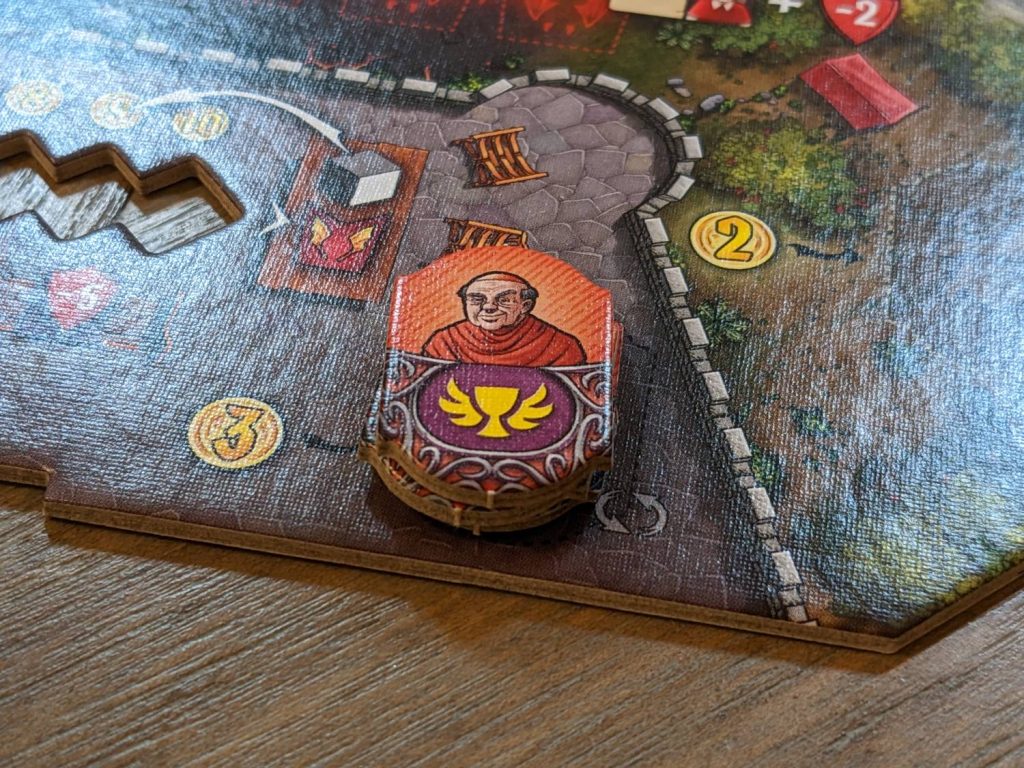
EXACTLY Four Players
The first thing you need to know about Deal with the Devil is that it requires exactly four players. I know this because it says it right on the side of the box:
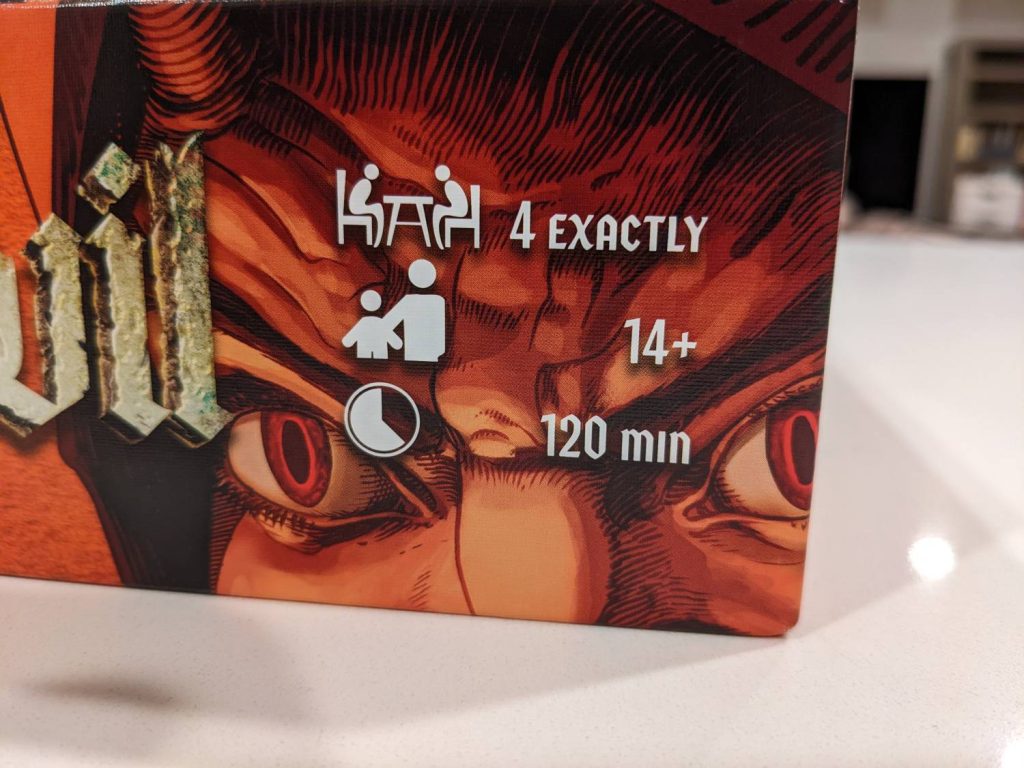
Crescent Moon pushed players into a minimum four, maximum five-player count. Solo-only gaming firmly cemented its status in the gaming world over the last year or two. I finally played Road to Canterbury, since we had a night where we “needed” a three-player-only experience. Two-player-only versions of every existing multiplayer game in history seem to be hitting retail (excuse me while I pack up my copy of Splendor Duel, because the world needed a two-player-only version of Splendor, apparently!).
2022 seemed to be the year where designers decided that we needed more “exactly ____ players” games. No problem. Of all the issues I have with this game, the four-player requirement is not one of them.
The issues begin when I tell you what Deal with the Devil’s gameplay is all about.
Deal with the Devil is a five-round hidden role, hidden trading, engine-building efficiency game with a voting system and Eurogame-style achievements. It does feature the use of an app, but in one of the game’s most pleasant positives, the app is not used to play the game, but rather to sort out who will receive each chest, which players use to make deals with others.
And one more thing—even though the rulebook is written with my kind of snark (snark that will feel familiar to players of other Czech Games productions like the Galaxy Trucker series), there are a lot of rules. Even the sponsored teach video is 37 minutes long (On Mars heavy Euro territory); unless your name is Paul Grogan, it will probably take you an hour or more to teach Deal with the Devil.
Most people I know who enjoy hidden role games expect those games to be light on rules. Deal with the Devil goes the other way, by featuring 6-8 phases in each of the game’s five rounds. One of these phases requires an understanding of a trade market that is by definition undefined in the early stages of the game.
Stay with me here. Deal with the Devil is mostly a production and building game, where all players can build cards from their hand in the same way, by spending resources. However, you won’t have any real idea how to get what you want through the trade market until it might be too late.
Deal with the Devil is also, occasionally, a hidden role game where the players have different powers and objectives. However, with information so limited that you will be blind guessing for a good portion of the game, you may hand a player a boatload of negative points halfway through the game.
And, worst (or best!) of all, you will have almost no idea what anyone’s score is until the end of the game.

Star of the Show
While I love Crescent Moon, there’s no question that a couple of the roles are just more interesting than the others, most notably the Nomad and the Murshid. The Nomad is so cool that this faction isn’t even available unless the game is played with exactly five players, and even though I lost that play of Crescent Moon, playing as the Nomad was the most fun I had with that game.
Deal with the Devil has a similar problem. There are three different roles randomly assigned to the four players, who serve as rulers of four medieval kingdoms hoping for an “architectural renaissance” (from the rulebook):
- Two players are “puny mortals.” Mortals start with three pieces of immortal soul, but this is made available to be traded for things like gathering money and resources to construct buildings.
- One player is the Cultist. This player has already joined a secret cult when the game begins and, as such, has a few starting resources and slightly less soul—a soul which is already a little tainted. In my experience with the game, this is also the player that other mortals will usually guess is the Devil, at least early on.
- One player is the Devil. (Yes, the actual Devil. In the game’s backstory, the Devil has taken on the human form of one of the four rulers, and no one has noticed that this guy is more than a little shady.) The Devil has zero soul, tons of starting resources, and the ability to make the best deals early on since they have so much stuff. Their goal is simple: gather pieces of the other players’ souls to score points during the Inquisition phases in rounds three and five.
Period, point-blank: you want to play as the Devil. It’s the most interesting role, it’s fun to watch everyone try to figure out if you’re the Devil, you have unique scoring mechanics, and even if everyone figures out who you are by the end, every other player will look at you and wish they had been playing as the Devil.
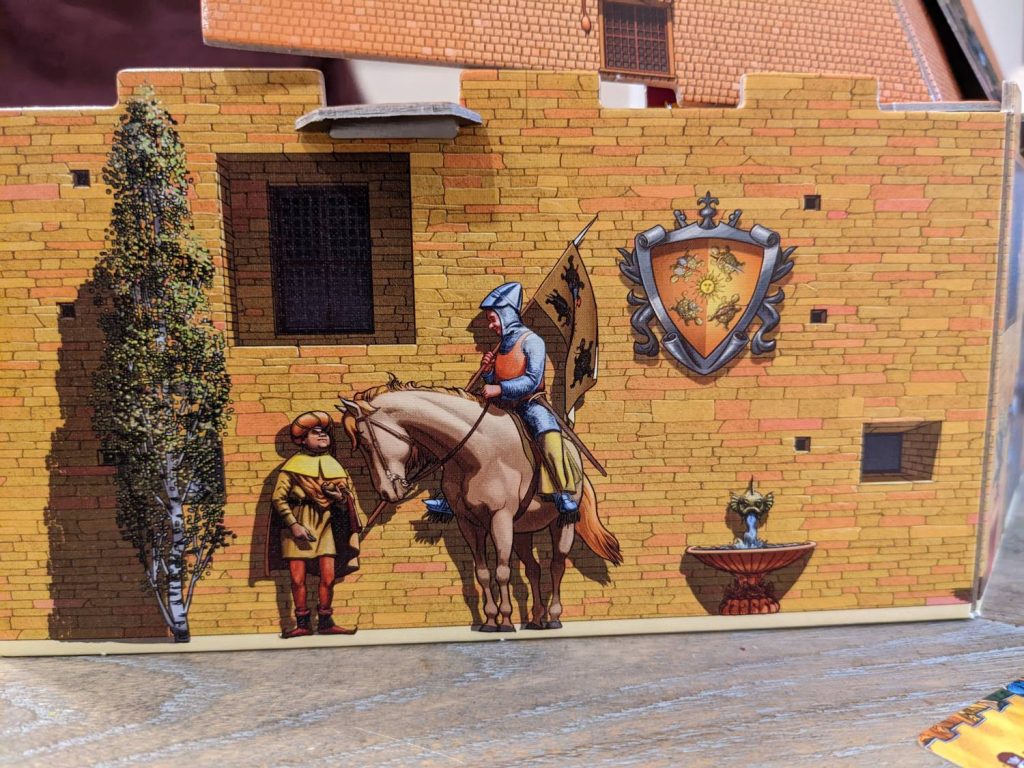
So, the Devil is the star of the show. (The game is called Deal with the Devil, right?) If you had to rank the order of the characters you would want to be, it would always be C, B, A. Who in their right mind is going to say “You know what, I hope I’m randomly assigned to be a ‘puny mortal’ and start the game with zero stuff”?
Right: no one. Deal with the Devil cascades down its jagged slope from there. Mortals start the game trying to figure out what a good deal looks like, knowing that they have to make deals to acquire the resources they need to build buildings. But soul is vital to surviving the game’s later voting steps (Witch Hunt and Inquisition), and giving up even a single piece of soul will make surviving these steps hard, maybe impossible.
Let’s talk about deals for a moment. To trade, each player will organize an offer that they want to make to the table. I say “table” because players will collect the items they are willing to trade in their chest, then set a dial to tell everyone what they want in return: money (if they are a mortal), money and/or souls (the Cultist), or just souls (the Devil).
(I’ll pause here for a moment to complain about something else: to throw players off the scent, why can’t players just trade stone for glass, or two wheat for a marble? The only market is money or souls in one direction, for cash or souls in the other direction. It’s just a strange idea for a trading game that I can’t just offer you a trade, man!!)
After closing their chest (and each chest shows that player’s role inside to avoid any confusion when you get your stuff back), all closed chests are handed to one player, then shuffled, then scanned in the app. The app then determines who your offer will go to first. Then that recipient considers the offer behind the massive player screen that is also their player board, then returns the chest to the center of the table, closed.
Then a second offer is made, again by shuffling chests and using the app. If the original offer wasn’t taken by the first player, that second player has a chance to consider it before it goes back to the original owner (and this is also done through the app, to ensure each chest goes back to the right person in secret).
The deals phase was quite the roller coaster in Deal with the Devil. Early on, nobody knows what a good deal looks like, unless it is utterly ridiculous (usually because the Devil has made an offer so juicy that someone jumps on that for a piece of their soul). A lack of trades really slowed the game for a couple of our players, which naturally slowed down the game’s engine-building elements with the building cards.
And in a game that seems to want players to build buildings, this is a problem.
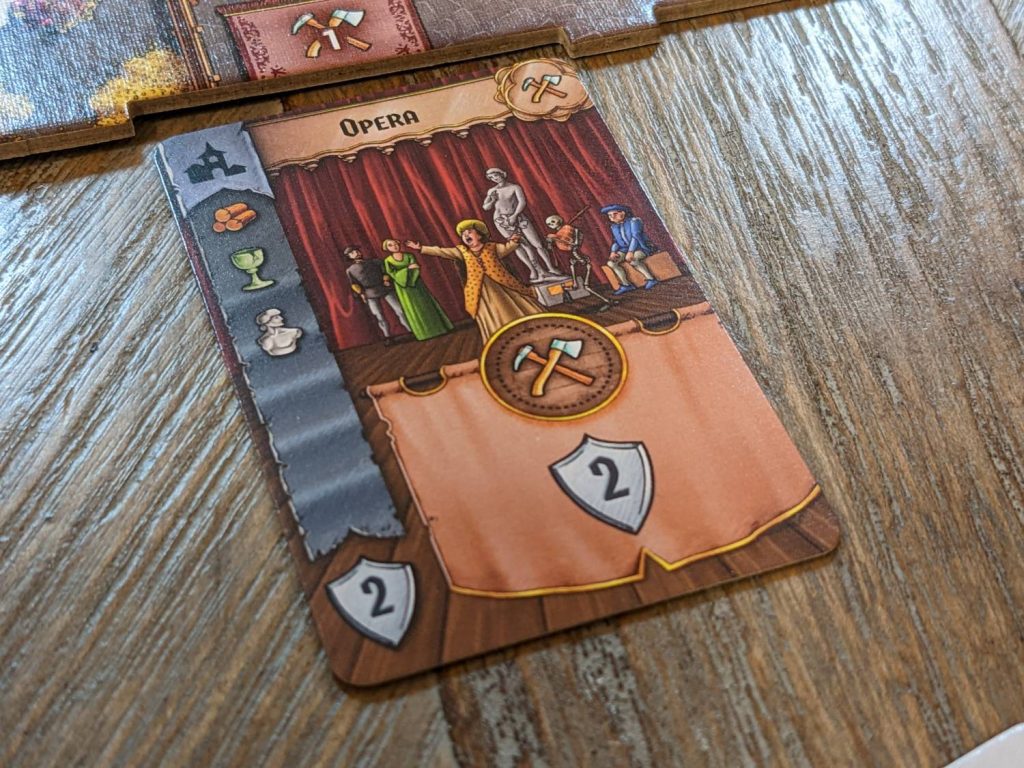
The Scoring
I could tell you more about the game’s systems, but that would pale in comparison to the scoring. Here’s my executive summary: I don’t like it.
I never like for a game’s score to be a complete surprise. But in Deal with the Devil, there’s no way around this because save for the points that players will receive at the end for their constructed buildings (public information), you don’t know who the Devil is, and they will be scoring most of their points differently.
But here is the biggest punch to the face for an efficiency puzzle lover like me: the game explicitly describes the need for all players to achieve an “architectural renaissance” by constructing buildings.
Deal with the Devil wants you to produce goods, optimize goods production, trade and make deals for resources, then build the cards in your hand, with new cards coming to you every round. Deal with the Devil also pushes hard for you to collect matching sets of building cards based on the card suit in the upper left-hand corner, earning you achievements that further optimize your engine.
Many of these elements are standard issue when deploying into yet another Euro-style engagement. The scoring should line up with this, but it does not. It was comedy at the end of play when two of the four players finished with a negative score despite building 7-9 buildings each and getting 6-8 of the eight total achievements available to each player.
I was one of those unlucky players, playing as the Cultist. I would have been better off just passing each turn, taking no actions, and finishing with zero points, rather than leaning into the game’s recommended rules. Now, part of this is on me, because it’s vital to monitor the Inquisitors during each of the game’s two Inquisition phases, because you’ll need to set aside a number of resources for each Inquisitor you cannot satisfy.

In those Inquisition phases, players could collectively bribe some of the cards on the table, to make those requirements go away. But the Euro gamer in me decided that I needed those valuable coins to build buildings instead of bribing officials. With everything being done in secret, it is hard to know which way to go during this phase.
Not a good look. If you have been maximizing production and using those resources to build buildings, bad news–the Inquisitors are going to hammer you during those phases. At one point in the final round, I had a score of -28 points before ending the game at -7. Another mortal was just above me, while the devil had 30 points and the other mortal had 16.
More scoring woes abound. The Cultist is told in the rules to get rid of those two pieces of starting soul, ideally giving away at least one of those before the first Inquisition. But, why? That soul is vital to paying off Inquisitors, and if you can get a piece of immortal soul from a mortal, that might give you the three pieces of soul you need to stave off a witch hunt.
But all that work amounts to a total loss of -2 points at the end of play if the Cultist still has both pieces of their starting soul in hand. NEGATIVE TWO POINTS???? I’m working the game around this? It feels so minor that it adds to my Spidey Sense that the Cultist might be the worst role in the game—it should be interesting to play the middle, but instead, players don’t want to trade soul to you, and you don’t have any special end-game scoring.
All the work you do to build buildings leads to cool things. Lots of the cards grant minor game-breaking powers, discounts on buying goods, or action cards that produce goods and/or points. Most of the cards are great. But when balanced against the negative points Inquisitors may take from each player, I’m not sure I would ever play Deal with the Devil with the mindset needed for most similar gaming experiences. That makes it unique, but very hard for most players to unlearn what has worked for them so well in the past.
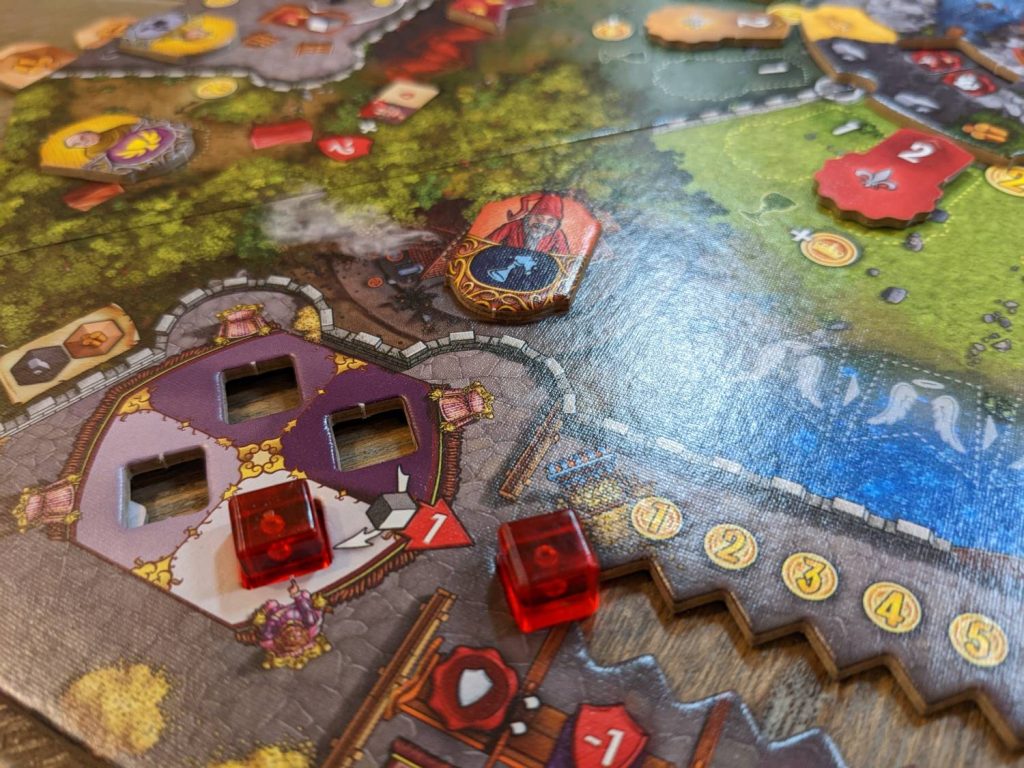
No Deal
Czech Games is the studio that has had maybe the best run of good games from a large publisher over the last 10 years; if you only considered Codenames, all its expansions, and Lost Ruins of Arnak, Czech Games (known as CGE) would be right at the top of the list of publishers in this regard. Adding games like Galaxy Trucker, Sanctum, Under Falling Skies, Through the Ages, Pulsar 2849…gosh, I don’t think I’ve ever played a bad game from CGE.
But Deal with the Devil isn’t nearly the game that I was hoping for. Like a couple other content creators I’ve spoken to, Deal with the Devil was the game I was most looking forward to from SPIEL ‘22. It does a couple of things well, particularly with app integration and another solid physical CGE production (even if it’s a mess to throw back into its box).
Almost everything else is a miss. This might be a game best for those who had been longing for a four-player-only Euro with hidden roles, but I don’t think I know anyone like that! The engine building has been done better by dozens of games this year alone. I don’t know if I’d say Deal with the Devil bleeds theme, even if it is cool to say that you’re starring as the Devil or that taking on debt feels right for the time period or that temptation is a very real thing.
The runtime can be long if players watch all others during the action phase, so that’s not recommended. But the deals phase takes a while, and often ends with no deals being made early on, and that takes time. I would agree with the playtime listed on the box, which means 2-2.5 hours for a standard play. My first play was just over three hours.
I don’t think this game is interesting when playing as any role besides the Devil. I do think players need to commit to many plays—let’s say 7-10 at a minimum, playing as each role at least twice—to really understand where each role is coming from, and how to make early-game dealmaking worthwhile. That’s a hefty time commitment for a below-average game.
Even though this is a “First Take” article, I won’t be coming back to Deal with the Devil because of one reason: I want to try out the other roles in the game, but by definition roles in each game are distributed randomly. There’s not a guarantee I could play as the Devil or as a “puny mortal” in future plays. Worse, I don’t think my review group wants to play this again, and multiple three-hour sessions will be a tough sell.


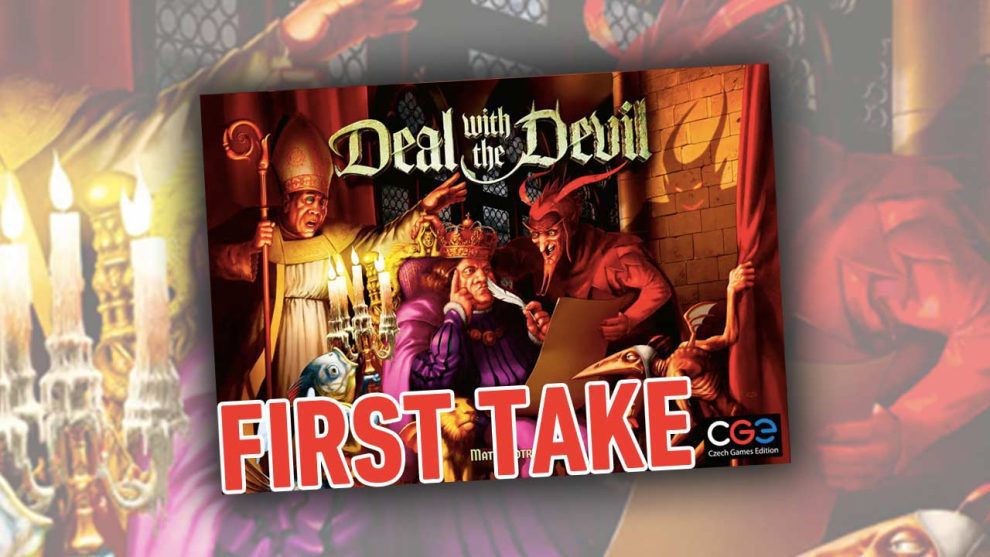









Add Comment